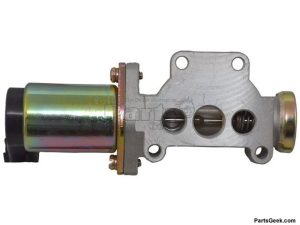Sometimes, the Motor Gods favor and you figure out how to fix what seems as though it might cost a lot to fix it for just a few bucks. When that happens, it’s a proper thing to convey to others, so that maybe they’ll be able to do the same.
My ’02 Nissan Frontier’s AC system hasn’t been working well for months. More finely, it has been working sporadically. It would blow cold, then warm. Then – after awhile – it might blow cold again. When this happens, the first thing one tends to think of is that the AC system is low on charge or that the compressor is going south. Or the electronic climate control interface – but my truck does not have that. It’s old enough to still have manual AC controls, so that wasn’t the likely problem. Those controls worked, in that pushing the “AC” button resulted in a green light and an audible click, indicating the compressor switch had engaged.
I checked the system to find out whether it was low on refrigerant. It wasn’t. So, what else could it be? It turned out to be something simple – for once. And – even better – something inexpensive.
An AC clutch cycle switch. Basically, a temperature probe that sends a signal to the AC system to cycle on or off. It is located in the ductwork behind and underneath the glovebox, on the front seat passenger side of the truck.
And Nissan actually designed it to be easy to replace, an even better thing. All I had to do was remove the glove box – held in place with five easy-to-remove screws. Once the glovebox was out, the AC ductwork was fully exposed. Also the fan for the AC (and heat) which I was glad to see because if I ever need to replace that, it will also be easy. It is sometimes not easy to get at parts like these in newer vehicles, which seem to have been designed to make it so not-easy most people will give up and leave it to the dealer. Which may be easy but rarely inexpensive.
Anyhow, after removing three more screws to allow for the lower section of the air box/ductwork to be opened enough to get my hand inside, all I had to do was remove the old switch, which is basically a probe like the one you use at Thanksgiving to make sure the turkey’s cooked – and install the new one. The whole job took me maybe 30 minutes – and cost me $37.50 and nothing in labor.
The AC blows cold now. Not cold – and then warm.
I also fixed something else, inadvertently. 
My truck’s idle used to surge whenever I pushed the clutch in; the revs would climb to 1,500 or so and then back to around 1,000 and do that back-and-forth for a little while before settling down. One of my mechanic friends told me it might be a problem with the ECU – the main brain computer that controls the idle. I thought it might be the idle air control motor – and replaced it, which was not an easy job courtesy of the soft aluminum screws beloved by Japanese automakers that are really easy to strip if you do not use the right-size Japanese screw removal tool. Plus you have to basically remove the throttle body and peripherals to get at the IAC motor assembly.
All that work – and no reward. The idle continued to surge and I sighed and said to myself: Well, it’s an old truck. This happens. It’s just a minor annoyance, regardless.
I didn’t connect the dots until just now.
Because the idle no longer surges. Apparently because the ECU is once again getting the right signal from that little red probe. When it wasn’t, it didn’t know whether to raise or lower the engine RPM to compensate for the additional load on the engine of the engaged compressor. It made me think of the way (back in the day) an engine’s idle would be kicked up a notch by a solenoid attached to the throttle arm on the carburetor. This was necessary to prevent the engine from dying – due to the load imparted by the compressor when it was turned on. In the olden days, you could feel the engine shudder when those massive compressors engaged.
Modern-ish vehicles like my old truck have compressors that don’t have as obvious an effect on the engine, but the extra load does require a little compensatory increase of the idle speed and without the necessary data – provided by the probe – the ECU was having serial Biden Moments trying to remember whether to increase or decrease the idle.
Both fixed now – and for less than $40!
. . .
If you like what you’ve found here please consider supporting EPautos.
We depend on you to keep the wheels turning!
Our donate button is here.
If you prefer not to use PayPal, our mailing address is:
EPautos
721 Hummingbird Lane SE
Copper Hill, VA 24079
PS: Get an EPautos magnet or sticker or coaster in return for a $20 or more one-time donation or a $10 or more monthly recurring donation. (Please be sure to tell us you want a magnet or sticker or coaster – and also, provide an address, so we know where to mail the thing!)
If you like items like the Baaaaaa! baseball cap pictured below, you can find that and more at the EPautos store!












I think I have a similar problem with my 04 Highlander. Sometimes when I sit in traffic and the radiator fan comes on, the car shudders at low idle for a second or two and then kicks the idle up a notch.
Eric,
That’s the thermostat, same problem I have with my VW Rabbit pickup. Can’t find a new one so I jumped the wiring. I have to remember to cycle the a/c on and off or it starts spitting ice out the vents. I’m sure if I looked around I could find a used one or try to adapt one from another car. That totally makes sense with the idle issue you were having.
There are generic thermal switches, I have one on my 91 truck. The conversion to 134a went too well, the line into the pump was frosting almost to the pump, not good. The one I have is adjustable as well even though it says “fixed”. There are others that have a half moon shaft adjuster for a knob.
https://www.amazon.com/Four-Seasons-35720-Mounted-Temperature
Sorry bum link paste, search Amazon for Four Seasons 35720
nice troubleshooting. A lost art.
I had the same issue with my ’05 Subaru Outback, diagnosed by the mechanic. However, that switch for me was buried behind the dashboard, requiring the whole dash to be taken apart. So I left it. Was thinking about doing some kind of bypass, but it worked well enough to be just a minor annoyance. Ended up trading it in for a ’24 Outback.
Man, o man, am I glad I am not the one who drives that ’24! ALL THE NANNY STATE stuff!!! I purposely do not drive that car. When me and my wife go somewhere, she drives…. She used to be a speed demon around in town, but only do 65max on the freeway. (schitzo) Somehow, with the new Subaru, she drives at least 10% below the posted speed limit. Everywhere (It has a speed limit icon displayed based on the GPS.) The little icon goes red if over. (Thankfully not the whole screen.) Between that and the “Lane Keeping Assist”, and other stuff, there’s no way in hell I would drive one of those for myself. It is truly a transportation appliance. That’s too bad, b.c Subaru’s are very decent cars: Simple drivetrain layout and you *cannot* get them stuck in the snow!
“she drives at least 10% below the posted speed limit.”
She’s a menace. Get her up to the already artificially low speed limit or off the roads.
Good luck with that
LOL
I know that feeling: Even the massive Rocket 455 under the hood of my 1968 Oldsmobile Delta 88 would shudder when that also massive Frigidaire A6 compressor kicked on.
It’s amazing to think how that old compressor put that kind of a load on that Rocket 455–an engine powerful enough to launch that 2 1/2 ton car into orbit. If I recall, it had a switch to not only compensate for idle, but also a switch to cut out the compressor at high engine speeds. (You might or might not notice, because that old Frigidaire system could turn the interior to Frankie Carbone in the meat truck cold in minutes.)
Hi Bryce,
Yup! I can feel the TA’s 455 bear down when I turn on the AC – and that 455 has ben modded to make probably 320 or so horsepower and 450-plus foot pounds of torque. But the AC is really cold, as you say. As opposed to cool – as it is in new cars.
Freon R-12 was banned because the patent protections ran out. Nothing more. The chlorine molecule is too “heavy” to make it to the upper atmosphere. The scientific justification for the banning of Freon R-12 was based on faulty science–not unlike that being pushed by the global warming climate change crowd.
Today’s refrigerants are much less efficient while the most recent approved refrigerants are flammable as well.
As far as I a concerned, Freon R-12 is still the best refrigerant for both automotive and stationary situations.
And non toxic. I have mild asthma the propellant in the inhalers back in the day was R12. One I liked and was very effective just flat disappeared once the ban launched, no exception for medical use. I don’t know what’s in the current albuteral rescue inhaler but I’m still here 20 years on.